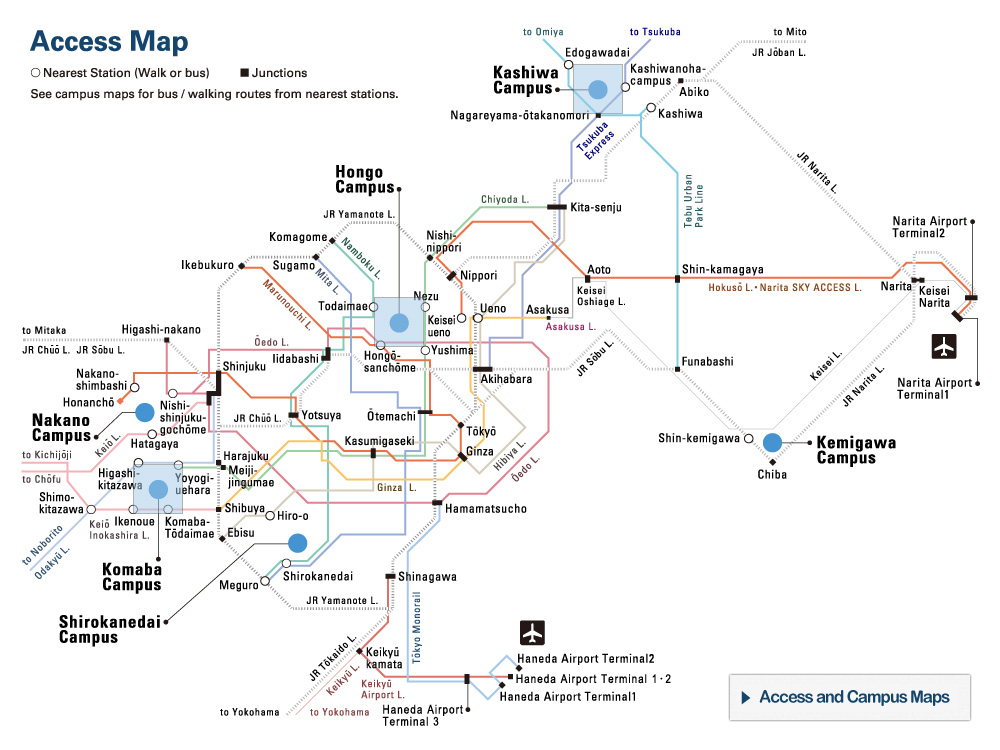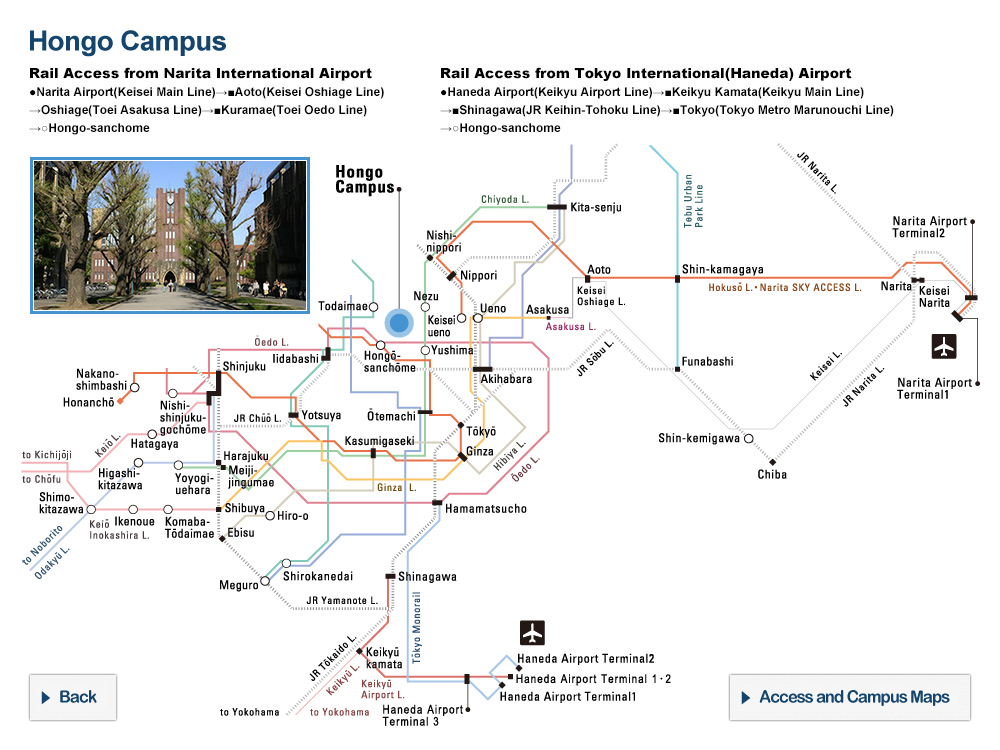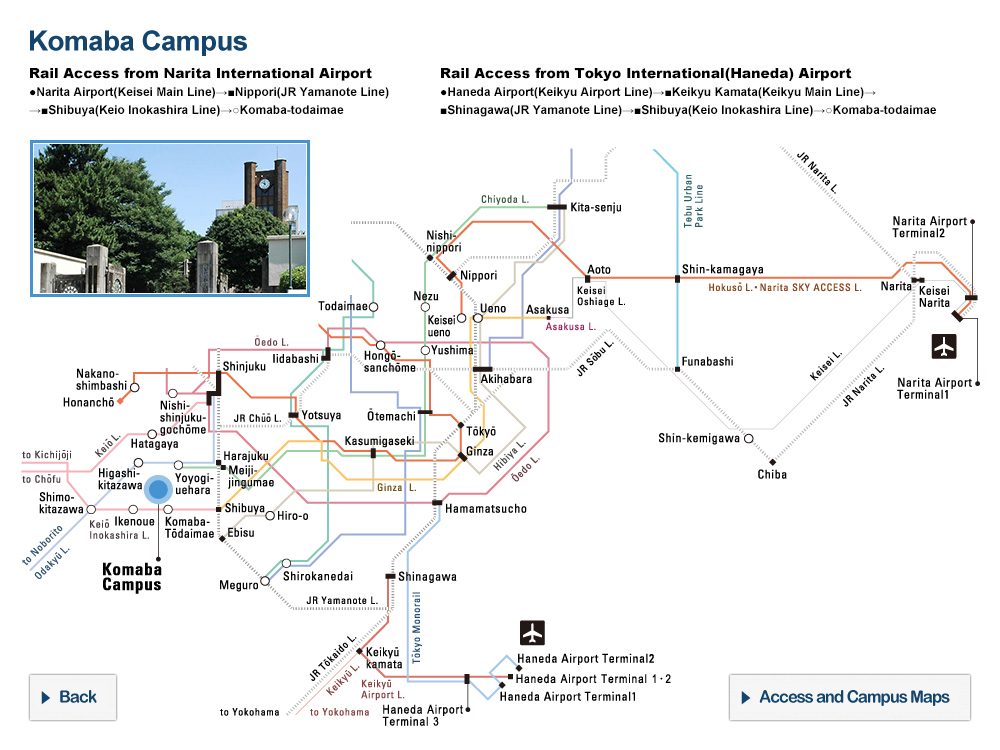Tour of Hyper-Kamiokande’s Massive Vertical Cavern Held in Hida, Japan Facility Scheduled to Begin Operations in 2028
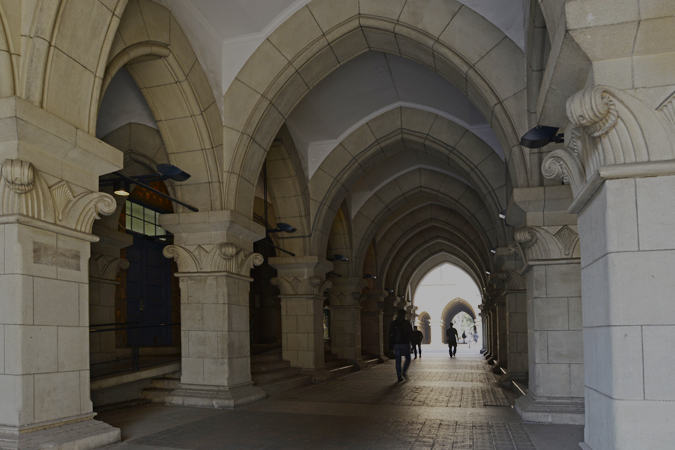
On June 28, 2025, a special tour of the construction site for the Hyper-Kamiokande project was held in Hida City, Gifu Prefecture, Japan. Hyper-Kamiokande is a next-generation international scientific research facility scheduled to begin operations in 2028. Approximately 70 participants attended the event, including representatives from the University of Tokyo, Japan’s Ministry of Education, Culture, Sports, Science and Technology (MEXT), Gifu Prefecture, and construction-related companies.
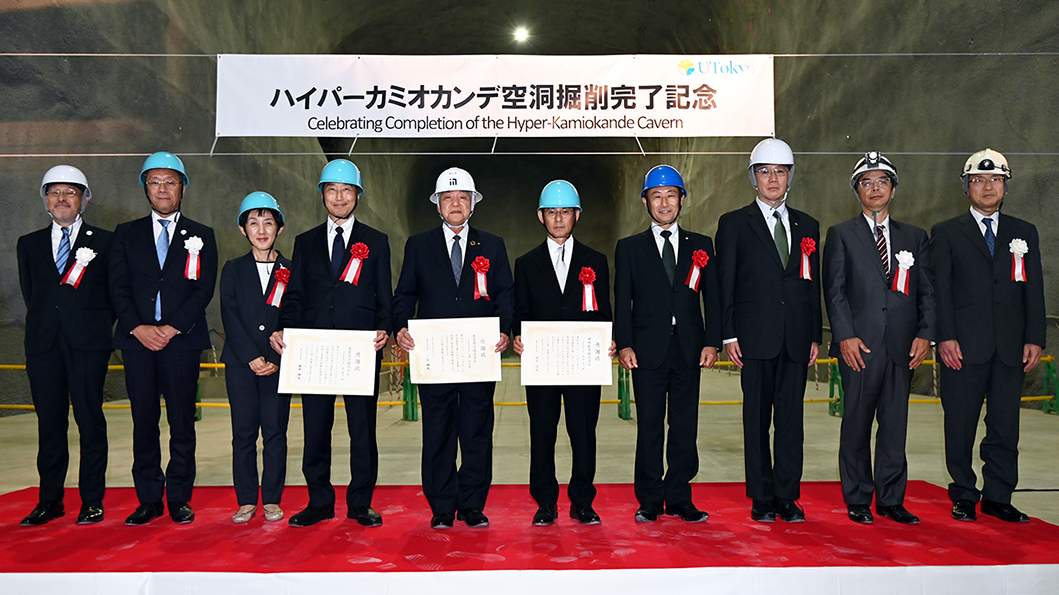
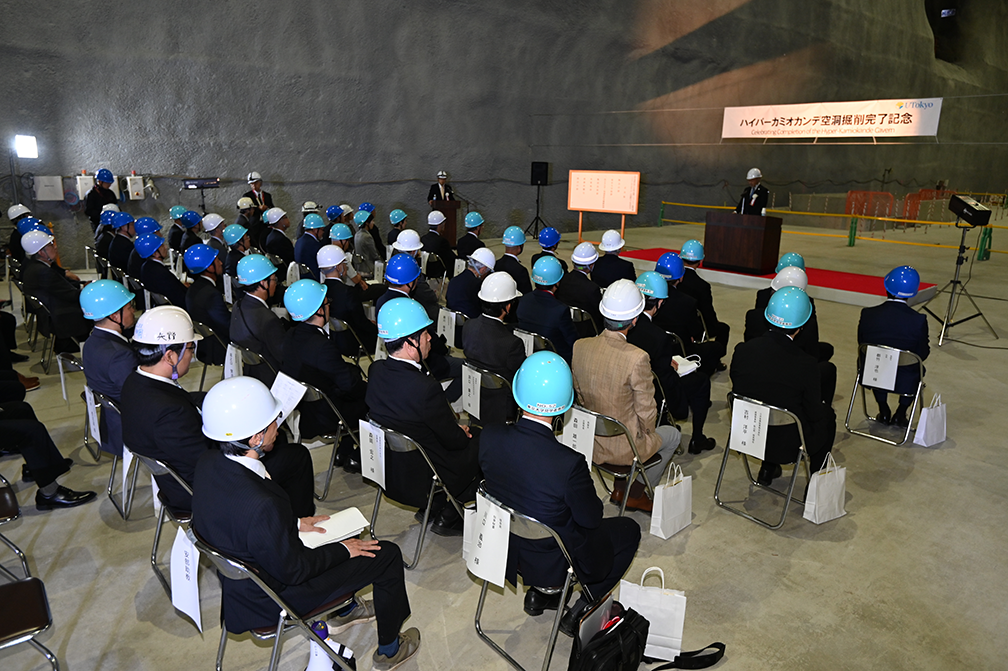
The Hyper-Kamiokande detector is designed to have a fiducial mass eight times greater than its predecessor, Super-Kamiokande, and will be equipped with newly developed, high-sensitivity photosensors. The project aims to advance our understanding of the Grand Unified Theory and the evolutionary history of the universe by investigating phenomena such as proton decay, CP violation (the asymmetry between neutrinos and antineutrinos), and observing neutrinos from supernova explosions. The construction budget was officially approved by the Japanese Diet in February 2020, marking the formal launch of the project. Excavation of the main cavern began in November 2022, following the completion of both the approach and access tunnels. The main dome, measuring 69 meters in diameter and 21 meters in height, was completed in October 2023, and excavation of the vertical cavern for the main detector has been ongoing since then.
Now nearing completion, the vertical cavern—located 600 meters underground—is one of the largest underground spaces in the world. It consists of a dome-shaped ceiling section approximately 69 meters in diameter and 21 meters in height and a cylindrical portion that is 73 meters in height and is located just below. It will house Hyper-Kamiokande’s enormous water tank, which will be fitted with approximately 20,000 newly developed photosensors and around 1,000 multi-photosensor modules designed to detect the faint light produced by neutrino interactions.
The ceremony, presided over by ICRR Associate Professor Yoichi Asaoka, was held at the underground site designated for the future installation of Hyper-Kamiokande’s water purification systems. Following opening remarks by Shoichi Ogio, Director of ICRR, key figures involved in the project—University of Tokyo President Teruo Fujii, KEK Director-General Shoji Asai, and Masato Shiozawa, Director of the ICRR Kamioka Observatory—delivered their comments. This was followed by congratulatory speeches from distinguished guests: Mizue Shiomi, Director of the Research Promotion Bureau at MEXT; Yoshihide Ezaki, Governor of Gifu Prefecture; Yoshikazu Oshimi, Chairman and Executive Director of Kajima Corporation; and Nobutaka Tanabe, Executive Director of Kamioka Mining and Smelting Corporation.
As part of the ceremony, President Fujii presented certificates of gratitude to the construction companies—Kajima Corporation, Tokyo Electric Power Services Corporation, and Kamioka Mining and Smelting Corporation—in recognition of their contributions. The event concluded with closing remarks by Shigetaka Moriyama, Deputy Director of ICRR.
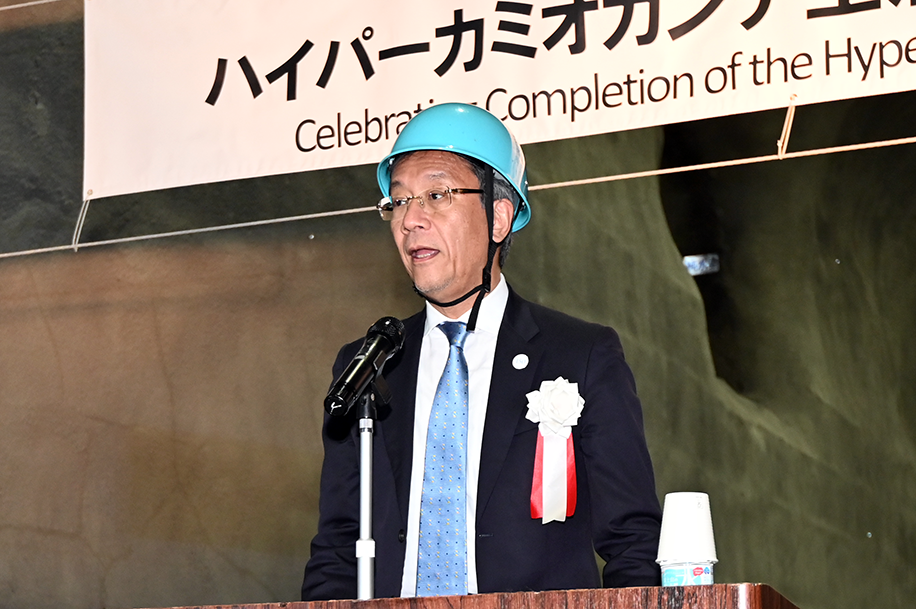
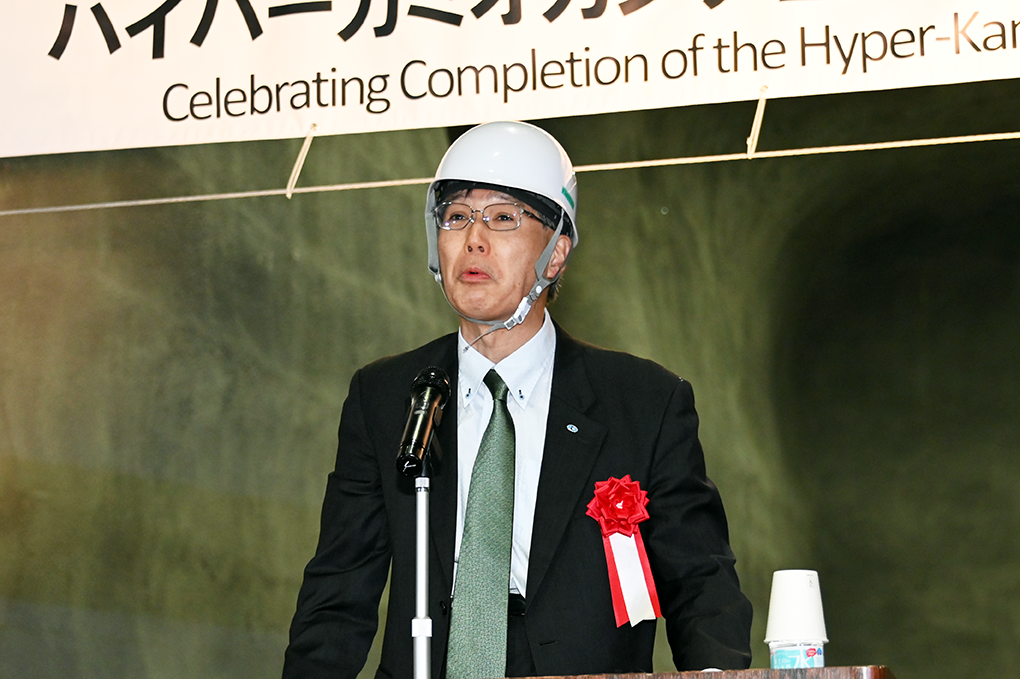
President Fujii stated:
“The excavation of the large cavern is nearly complete, and we are able to hold this tour thanks to the tremendous support from many people, including those present here today. I would like to take this opportunity to express my deepest gratitude. Fundamental scientific research will be conducted here, and I hope it will help present a bright future to children who will lead the next generation. Over the next 20 years of observation, Hyper-Kamiokande will become a hub for international collaborative research, attracting scientists from around the world. I am confident that it will not only embody UTokyo Compass's goal* of ‘Pursuing Knowledge,’ but it will also foster young talent and contribute to ‘Nurturing People,’ as well as ultimately create a vibrant ‘Place for Discovery.’”
Director-General Asai of KEK, which co-hosts the project together with the University of Tokyo, followed President Fujii with the comment below:
“In Tokai Village, Ibaraki Prefecture, which is about 300 kilometers east of Kamioka, we have the J-PARC accelerator. It produces a large number of neutrinos, and they will be observed by Hyper-Kamiokande. There is a possibility that neutrinos are the particles that created the matter in our bodies, the Earth, and the universe, and this experiment aims to verify that. Toward the launch of the Hyper-Kamiokande experiment in 2028, KEK is working to improve the performance of the accelerator and is also preparing a new detector next to the accelarator. The detector is something like a miniature of Hyper-Kamiokande. We sincerely ask for continued support from MEXT, the University of Tokyo, and the people of Hida City and Tokai Village.”
Note*
In the foundational policy of “UTokyo Compass,” published in September 2021, the University of Tokyo set specific goals and action plans from three perspectives: “Pursuing Knowledge,” “Nurturing People,” and “Creating Places.”

Director Shiomi of MEXT's Research Promotion Bureau delivered a congratulatory message:
“I would like to once again express my deep respect for the achievement of creating this unprecedentedly large cavern, made possible by Japan’s outstanding excavation technology and the collective wisdom of world-leading researchers. ... MEXT has positioned this as a pioneering large-scale project that opens new frontiers in global academic research, and we have been providing our support accordingly. The neutrino research field has been led by Japanese scientists such as Dr. Masatoshi Koshiba and Dr. Takaaki Kajita, and I understand that this progress has been supported by the facilities in Kamioka—Kamiokande and Super-Kamiokande. Now that the excavation for Hyper-Kamiokande is nearly complete, we are entering the next stage. MEXT will continue to support this bold challenge to further advance humanity’s knowledge. I would like to extend my heartfelt congratulations on the steady progress of the Hyper-Kamiokande project, the great achievements it will bring, and the continued health and success of everyone involved.”
We aim to work step by step, in close collaboration with international colleagues, to build the water purification systems, construct the massive water tank, install the photosensors, fill the tank with purified water, and conduct test operations—so that Hyper-Kamiokande can begin its experiments in 2028.
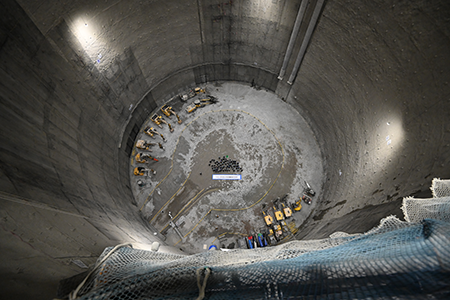
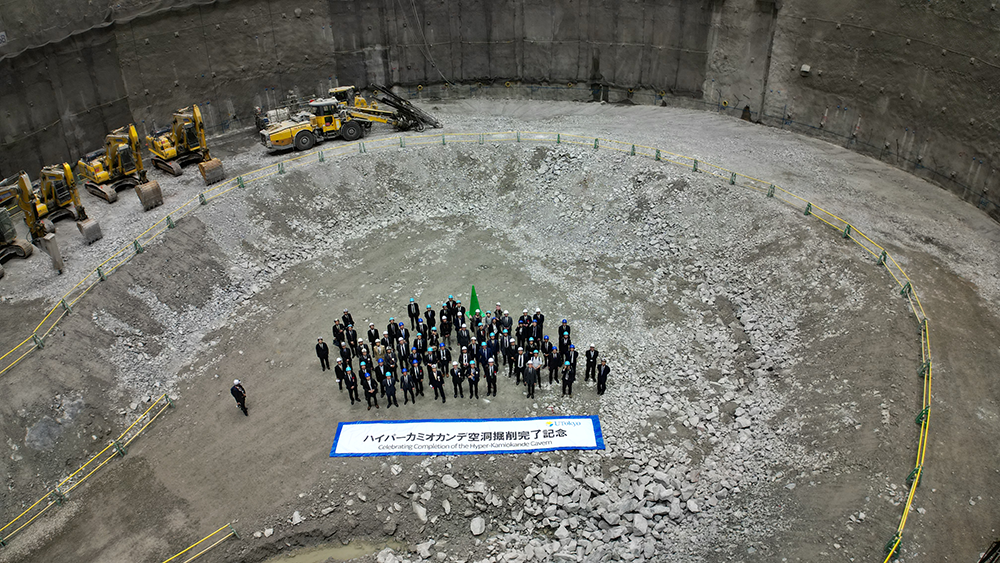
Public Lecture and Site Tour of Hyper-Kamiokande Attract Enthusiastic Visitors
On the evening of June 28, a public lecture by Assistant Professor Hidekazu Tanaka of ICRR was held at Kamioka Town Hall. The event was moderated by Dr. Yuki Akimoto, who runs a website called ‘HiggsTan’ and has been documenting the construction of Hyper-Kamiokande.
In his talk, titled “Hyper-Kamiokande and the Excavation of a Large Underground Cavern,” Assistant Professor Tanaka gave an overview of the entire Hyper-Kamiokande project and spoke in detail about the excavation process, including the challenges encountered.
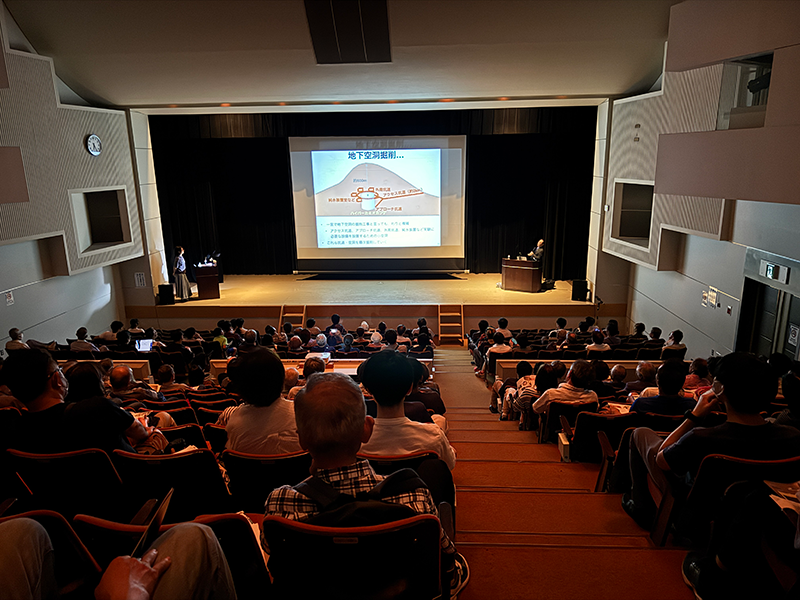

The following day on June 29, approximately 600 visitors participated in a guided tour of the Hyper-Kamiokande construction site with the help of the local community. They were chosen by lottery from among applicants, half of whom were from Hida City and the other half from across Japan. Applications were about 42 times and 4 times the number of available spots for the nationwide and Hida quartus, respectively. Divided into 12 groups, participants gathered at Kamioka Town Hall at designated times and boarded buses for the tour, which lasted about two hours. Upon reaching the bottom of the massive underground cavern—measuring 69 meters in diameter and 94 meters in height—visitors were awestruck, exclaiming reactions such as “Wow, it’s huge!” and “How did they build something this massive underground?” They then moved to an upper observation level to view the cavern from above, carefully taking photos and marveling at the scale of the structure. The tour also included a visit to the large space designated for the water purification systems. At each stop, researchers provided direct explanations and answered questions from the visitors. At the end of the tour, many participants wrote heartfelt messages of appreciation to the researchers and construction teams, expressing their admiration and gratitude for the project.
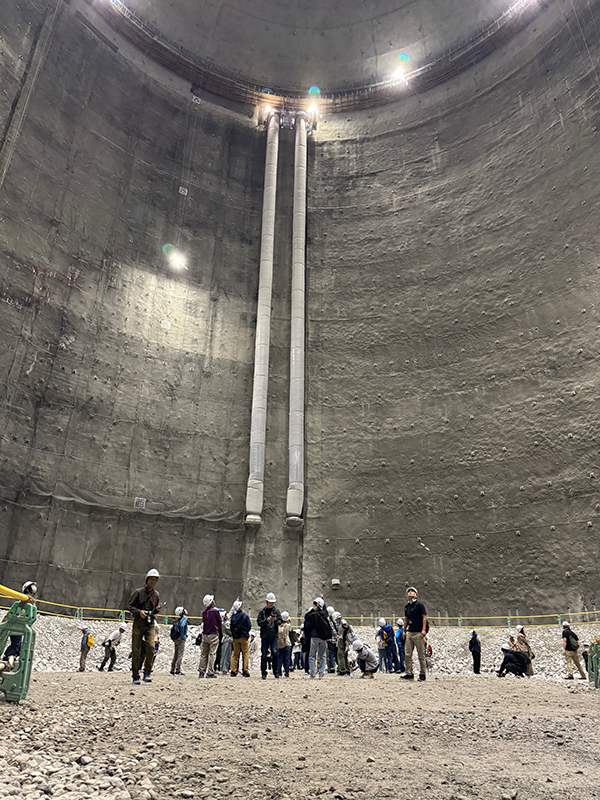
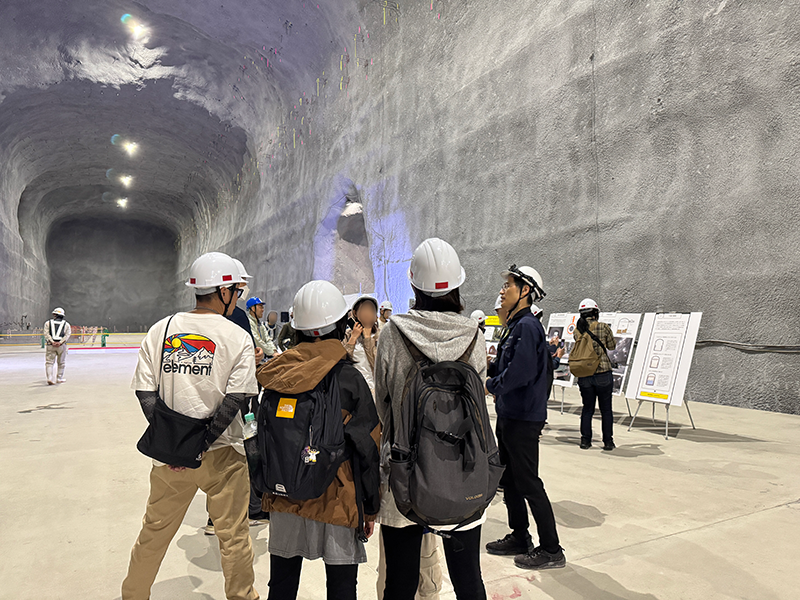
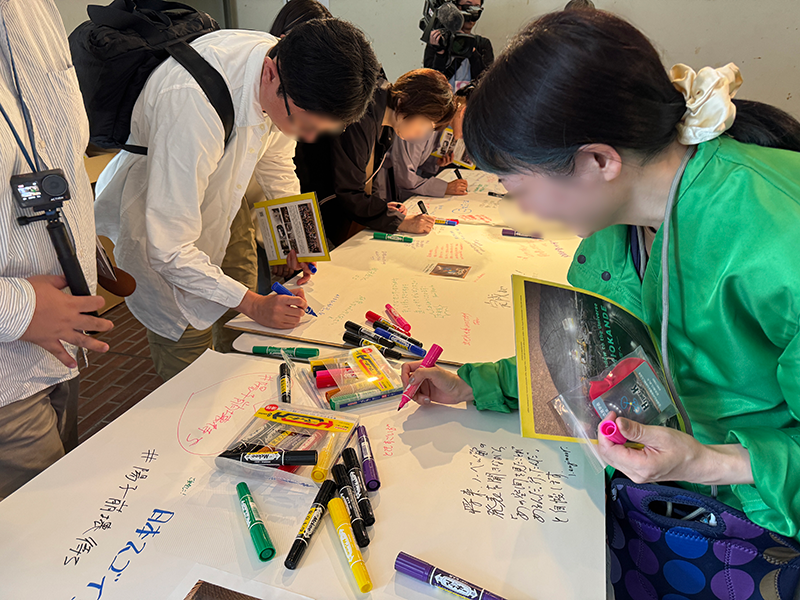

Speakers at the Ceremony for the Hyper-Kamiokande Site Tour for Invited Guests
From left to right: Shoichi Ogio, Director of the Institute for Cosmic Ray Research (ICRR), The University of Tokyo; Teruo Fujii, President of The University of Tokyo; Mizue Shiomi, Director of the Research Promotion Bureau, MEXT; Yasuhiro Kubo, President of Tokyo Electric Power Services Corporation; Yoshikazu Oshimi, Chairman and Executive Director of Kajima Corporation; Nobutaka Tanabe, Executive Director of Kamioka Mining and Smelting Corporation; Yoshihide Ezaki, Governor of Gifu Prefecture; Shoji Asai, Director-General of the High Energy Accelerator Research Organization (KEK); Masato Shiozawa, Director of the Kamioka Observatory, ICRR, The University of Tokyo; Shigetaka Moriyama, Deputy Director of ICRR, The University of Tokyo.
From left to right: Shoichi Ogio, Director of the Institute for Cosmic Ray Research (ICRR), The University of Tokyo; Teruo Fujii, President of The University of Tokyo; Mizue Shiomi, Director of the Research Promotion Bureau, MEXT; Yasuhiro Kubo, President of Tokyo Electric Power Services Corporation; Yoshikazu Oshimi, Chairman and Executive Director of Kajima Corporation; Nobutaka Tanabe, Executive Director of Kamioka Mining and Smelting Corporation; Yoshihide Ezaki, Governor of Gifu Prefecture; Shoji Asai, Director-General of the High Energy Accelerator Research Organization (KEK); Masato Shiozawa, Director of the Kamioka Observatory, ICRR, The University of Tokyo; Shigetaka Moriyama, Deputy Director of ICRR, The University of Tokyo.

Ceremony held in cavern of Hyper-Kamiokande
The Hyper-Kamiokande detector is designed to have a fiducial mass eight times greater than its predecessor, Super-Kamiokande, and will be equipped with newly developed, high-sensitivity photosensors. The project aims to advance our understanding of the Grand Unified Theory and the evolutionary history of the universe by investigating phenomena such as proton decay, CP violation (the asymmetry between neutrinos and antineutrinos), and observing neutrinos from supernova explosions. The construction budget was officially approved by the Japanese Diet in February 2020, marking the formal launch of the project. Excavation of the main cavern began in November 2022, following the completion of both the approach and access tunnels. The main dome, measuring 69 meters in diameter and 21 meters in height, was completed in October 2023, and excavation of the vertical cavern for the main detector has been ongoing since then.
Now nearing completion, the vertical cavern—located 600 meters underground—is one of the largest underground spaces in the world. It consists of a dome-shaped ceiling section approximately 69 meters in diameter and 21 meters in height and a cylindrical portion that is 73 meters in height and is located just below. It will house Hyper-Kamiokande’s enormous water tank, which will be fitted with approximately 20,000 newly developed photosensors and around 1,000 multi-photosensor modules designed to detect the faint light produced by neutrino interactions.
The ceremony, presided over by ICRR Associate Professor Yoichi Asaoka, was held at the underground site designated for the future installation of Hyper-Kamiokande’s water purification systems. Following opening remarks by Shoichi Ogio, Director of ICRR, key figures involved in the project—University of Tokyo President Teruo Fujii, KEK Director-General Shoji Asai, and Masato Shiozawa, Director of the ICRR Kamioka Observatory—delivered their comments. This was followed by congratulatory speeches from distinguished guests: Mizue Shiomi, Director of the Research Promotion Bureau at MEXT; Yoshihide Ezaki, Governor of Gifu Prefecture; Yoshikazu Oshimi, Chairman and Executive Director of Kajima Corporation; and Nobutaka Tanabe, Executive Director of Kamioka Mining and Smelting Corporation.
As part of the ceremony, President Fujii presented certificates of gratitude to the construction companies—Kajima Corporation, Tokyo Electric Power Services Corporation, and Kamioka Mining and Smelting Corporation—in recognition of their contributions. The event concluded with closing remarks by Shigetaka Moriyama, Deputy Director of ICRR.

UTokyo President Teruo Fujii

KEK Director-General Shoji Asai
President Fujii stated:
“The excavation of the large cavern is nearly complete, and we are able to hold this tour thanks to the tremendous support from many people, including those present here today. I would like to take this opportunity to express my deepest gratitude. Fundamental scientific research will be conducted here, and I hope it will help present a bright future to children who will lead the next generation. Over the next 20 years of observation, Hyper-Kamiokande will become a hub for international collaborative research, attracting scientists from around the world. I am confident that it will not only embody UTokyo Compass's goal* of ‘Pursuing Knowledge,’ but it will also foster young talent and contribute to ‘Nurturing People,’ as well as ultimately create a vibrant ‘Place for Discovery.’”
Director-General Asai of KEK, which co-hosts the project together with the University of Tokyo, followed President Fujii with the comment below:
“In Tokai Village, Ibaraki Prefecture, which is about 300 kilometers east of Kamioka, we have the J-PARC accelerator. It produces a large number of neutrinos, and they will be observed by Hyper-Kamiokande. There is a possibility that neutrinos are the particles that created the matter in our bodies, the Earth, and the universe, and this experiment aims to verify that. Toward the launch of the Hyper-Kamiokande experiment in 2028, KEK is working to improve the performance of the accelerator and is also preparing a new detector next to the accelarator. The detector is something like a miniature of Hyper-Kamiokande. We sincerely ask for continued support from MEXT, the University of Tokyo, and the people of Hida City and Tokai Village.”
Note*
In the foundational policy of “UTokyo Compass,” published in September 2021, the University of Tokyo set specific goals and action plans from three perspectives: “Pursuing Knowledge,” “Nurturing People,” and “Creating Places.”

Director Shiomi delivers a congratulatory speech
Director Shiomi of MEXT's Research Promotion Bureau delivered a congratulatory message:
“I would like to once again express my deep respect for the achievement of creating this unprecedentedly large cavern, made possible by Japan’s outstanding excavation technology and the collective wisdom of world-leading researchers. ... MEXT has positioned this as a pioneering large-scale project that opens new frontiers in global academic research, and we have been providing our support accordingly. The neutrino research field has been led by Japanese scientists such as Dr. Masatoshi Koshiba and Dr. Takaaki Kajita, and I understand that this progress has been supported by the facilities in Kamioka—Kamiokande and Super-Kamiokande. Now that the excavation for Hyper-Kamiokande is nearly complete, we are entering the next stage. MEXT will continue to support this bold challenge to further advance humanity’s knowledge. I would like to extend my heartfelt congratulations on the steady progress of the Hyper-Kamiokande project, the great achievements it will bring, and the continued health and success of everyone involved.”
We aim to work step by step, in close collaboration with international colleagues, to build the water purification systems, construct the massive water tank, install the photosensors, fill the tank with purified water, and conduct test operations—so that Hyper-Kamiokande can begin its experiments in 2028.


Invited guests gather at the bottom of Hyper-Kamiokande's cavern during their tour.
Public Lecture and Site Tour of Hyper-Kamiokande Attract Enthusiastic Visitors
On the evening of June 28, a public lecture by Assistant Professor Hidekazu Tanaka of ICRR was held at Kamioka Town Hall. The event was moderated by Dr. Yuki Akimoto, who runs a website called ‘HiggsTan’ and has been documenting the construction of Hyper-Kamiokande.
In his talk, titled “Hyper-Kamiokande and the Excavation of a Large Underground Cavern,” Assistant Professor Tanaka gave an overview of the entire Hyper-Kamiokande project and spoke in detail about the excavation process, including the challenges encountered.

Public lecture attended by 150 people

ICRR Assistant Professor Tanaka answers questions from the audience during his public lecture.
The following day on June 29, approximately 600 visitors participated in a guided tour of the Hyper-Kamiokande construction site with the help of the local community. They were chosen by lottery from among applicants, half of whom were from Hida City and the other half from across Japan. Applications were about 42 times and 4 times the number of available spots for the nationwide and Hida quartus, respectively. Divided into 12 groups, participants gathered at Kamioka Town Hall at designated times and boarded buses for the tour, which lasted about two hours. Upon reaching the bottom of the massive underground cavern—measuring 69 meters in diameter and 94 meters in height—visitors were awestruck, exclaiming reactions such as “Wow, it’s huge!” and “How did they build something this massive underground?” They then moved to an upper observation level to view the cavern from above, carefully taking photos and marveling at the scale of the structure. The tour also included a visit to the large space designated for the water purification systems. At each stop, researchers provided direct explanations and answered questions from the visitors. At the end of the tour, many participants wrote heartfelt messages of appreciation to the researchers and construction teams, expressing their admiration and gratitude for the project.

Visitors taking photos at the bottom of the cavern

Researchers explaining the water purification systems

Visitors writing messages to researchers



